Introduction
In this article, we will explore the diverse range of rice varieties in India and delve into their unique characteristics. Its versatility knows no bounds, allowing for a multitude of delicious preparations. Let’s celebrate the goodness of rice and appreciate its ability to bring joy to our meals.
As an Indian, rice holds a special place in our cuisine and culture. It is the most commonly consumed food and a staple in multiple states throughout the country. Despite being unfairly criticized for its association with weight gain, rice is a highly nutritious grain.
Rice is a versatile grain with a rich history in India, and it holds great significance in Ayurveda as well. Each state in India boasts its unique varieties of rice, contributing to the incredible culinary diversity of the country. There are numerous types of rice cultivated and consumed in India.
From aromatic Basmati rice to regional varieties like Sona Masoori, and Matta rice, the options are plentiful. Rice plays a vital role in Indian cuisine, with a multitude of delicious dishes relying on it as a key ingredient.
From biryanis to pulaos and from idlis to dosas, many iconic and mouthwatering Indian delicacies showcase the versatility of rice. Its significance and widespread usage make it an indispensable food item in India.
Rice History

Rice’s presence in Indian history can be traced back to the Yajur Veda (c. 1500-800 BC) and is frequently mentioned in Sanskrit texts. In Indian culture, rice is associated with prosperity and fertility, which is reflected in customs like throwing rice at newlyweds and offering rice as the first solid food to babies or to a husband by his new bride to ensure fertility.
Excavations at Hastinapur in India have revealed paddy grains dating back to 1000-750 BC, making them among the oldest samples in the world. The southwest Himalayas are considered a probable centre of origin for various types and varieties of rice.
India has played a significant role in the cultivation of rice, with historians suggesting that the indica variety of rice was first domesticated in the region encompassing the foothills of the Eastern Himalayas. This area extends from northeastern India through Burma, Thailand, Laos, Vietnam, and southern China.
The japonica variety, on the other hand, was domesticated from wild rice in southern China and later introduced to India. Assam and Nepal still have wild varieties of perennial rice growing. The cultivation of rice in southern India is believed to have emerged around 1400 BC after its domestication in the northern plains. From there, rice cultivation spread to the fertile alluvial plains irrigated by rivers.
Recommended Article: Pulses of India: A Flavorful Journey
Nutrition Value (per 100g)
Brown Rice:
Protein: 9.16g
Total fat:1.24g
Fibre: 4.43g
Carbohydrates: 74.80g
Parboiled Rice:
Protein: 7.81g
Total fat: 0.55g
Fibre: 3.74g
Carbohydrates: 77.16g
Milled Rice:
Protein: 7.94g
Total fat: 0.52g
Fibre: 2.81g
Carbohydrates: 78.24g
Popular Rice Varieties in India
There are a lot of rice varieties in India. Let’s learn about the 18 rice varieties in India in this article.
1. Basmati Rice
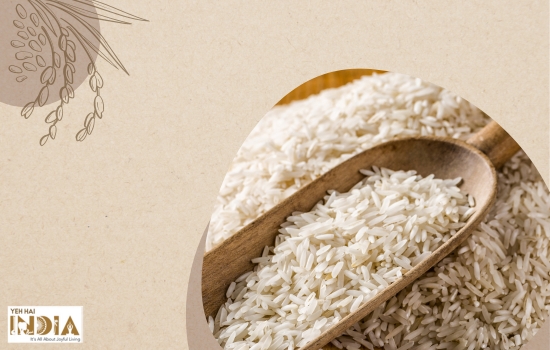
Renowned for its aromatic fragrance and long, slender grains. Basmati rice has a unique flavour. Biryanis and pilafs taste better when made of Basmati rice. Basmati rice enjoys widespread popularity in India and across Asia, being recognized as a prominent rice variety.
This aromatic rice variety plays a vital role in the creation of captivating and unique dishes found in Indian and Asian culinary traditions. Traditional Indian accompaniments, featuring fresh herbs and green onions, often complement this rice.
Majorly consumed in Andhra Pradesh, Gujrat, Haryana, Himachal Pradesh, Jammu and Kashmir, Punjab, Rajasthan, Telangana, Uttar Pradesh and Uttarakhand.
You can readily purchase Basmati rice, which comes in both white and whole-grain versions, at your local grocery store and on e-commerce sites.
2. Sona Masoori Rice

Sona Masoori rice is a medium-grain variety and is commonly used in India. It has a light and fluffy texture when cooked, making it ideal for everyday meals. The rice complements a variety of dishes, including pulao and biryani, with its ability to absorb flavours.
Rinsing the rice before cooking and using a 1:2 rice-to-water ratio is recommended. Sona Masoori rice’s versatility, pleasant taste, and wide availability have contributed to its popularity as a staple in Indian cuisine.
Majorly consumed in Andhra Pradesh, Karnataka, Odisha, and Telangana.
3. Jasmine Rice
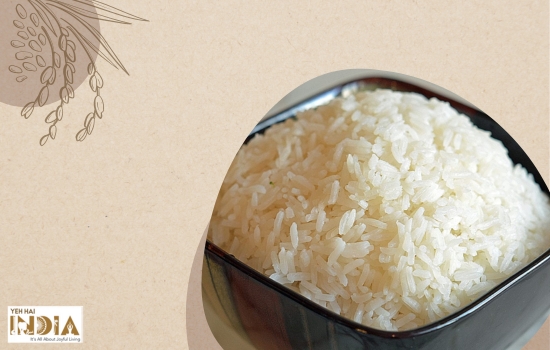
Originating in Thailand, Jasmine rice has gained popularity not only in its home country but also in India. This rice boasts a distinct floral scent and a slightly sticky texture when cooked, making it an ideal choice for dishes such as pulao and fried rice.
The primary cultivation of Jasmine rice takes place in Thailand, and once fully cooked, it exhibits a tender and adhesive consistency, enhancing the fragrance and flavour of most curry dishes. You can find Jasmine rice in both white and whole-grain varieties, each offering a delightful nutty taste.
Majorly consumed in Tamil Nadu, Karnataka, Kerala, and Andhra Pradesh.
4. Pusa Basmati Rice

Pusa Basmati rice stands as a hybrid variation of Basmati rice, celebrated for its elongated grains and delightful aroma. It enjoys popularity for domestic consumption and export purposes alike.
Sometimes simply referred to as Pusa rice, is a semi-dwarf hybrid plant sharing many attributes with traditional Basmati rice. It matches or even surpasses ordinary Basmati rice in terms of fragrance, alkaline content, and flavour.
Majorly consumed in Madhya Pradesh, Haryana and Punjab.
5. Ambemohar Rice
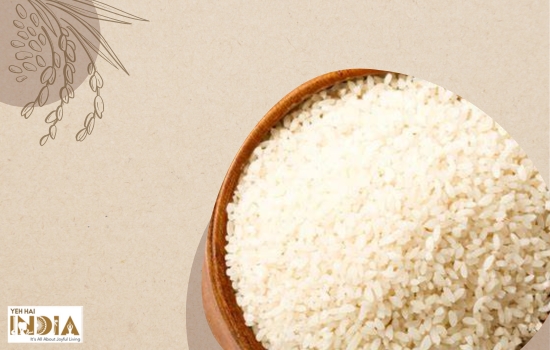
Ambemohar rice is a unique and aromatic rice variety commonly grown and consumed in Maharashtra, India. Its name translates to “fragrance of mango blossoms,” which is fitting given its distinct mango-like aroma. The grains are slender and elongated, and they have a soft and fluffy texture when cooked.
It is renowned for its delicate and subtle flavour, which pairs well with a variety of traditional Maharashtrian dishes. It is especially popular in the preparation of special rice dishes like Tambda and Pandhara Rassa and is also used to make fragrant pulao.
Due to its exquisite aroma and versatility, Ambemohar rice is treasured by rice enthusiasts and plays a significant role in the culinary traditions of Maharashtra.
Majorly consumed in Maharashtra, Goa and Gujarat.
6. Red Rice

Red rice, also known as Lal Qilla Rice or Rosematta Rice, is a variety of rice characterized by its reddish-brown colour and nutty flavour. It has a chewy texture and is a whole grain, as it undergoes minimal processing, retaining its bran and germ layers. It is rich in antioxidants, fibre, and nutrients like iron and zinc.
You can use Red rice to prepare traditional dishes like Red Rice Idli, Red Rice Pongal, and Red Rice Pulao, offering a healthier alternative to polished white rice.
Its distinctive colour and nutritional benefits have made red rice a popular choice for health-conscious individuals seeking to incorporate whole grains into their diet.
Majorly used in Goa, Kerala, Tamil Nadu, Arunachal Pradesh, Assam, Meghalaya and Sikkim.
7. Ponni Rice
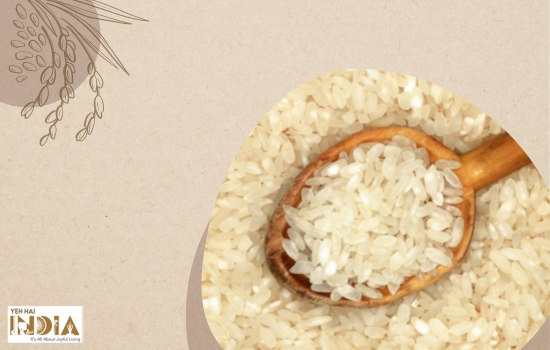
Ponni rice is a popular rice variety primarily cultivated in the southern states of India, particularly in Tamil Nadu and Karnataka. It has a unique aroma and is soft. When you cook it, the texture of the rice becomes fluffy.
The grains are medium-sized and have a light golden colour. Ponni rice is versatile and commonly used in various South Indian dishes such as idli, dosa, and sambar rice. It is also a preferred choice for making biryanis and pulao.
Majorly consumed in Tamil Nadu and Karnataka.
8. Dubraj Rice
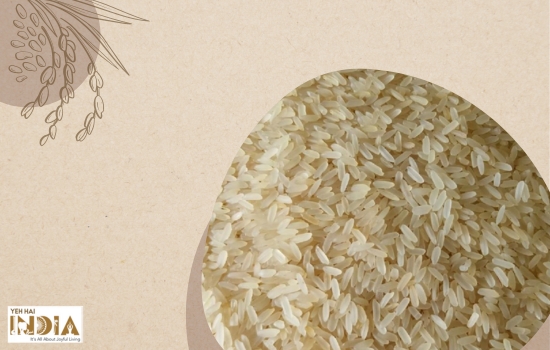
Dubraj rice is a variety of rice that is primarily grown and consumed in the eastern states of India. It is a short-grain rice with a distinct aroma and a soft, slightly sticky texture when cooked.
Known for its ability to absorb flavours well, it is a popular choice for biryanis, pulao, and other rice-based dishes.
It is also used to make traditional sweets and desserts in the region. Due to its local popularity, Dubraj rice holds cultural and culinary significance in the eastern states of India.
Majorly consumed in Madhya Pradesh and Chhattisgarh, particularly in the cities of Bilaspur and Jharkhand.
9. Indrayani Rice
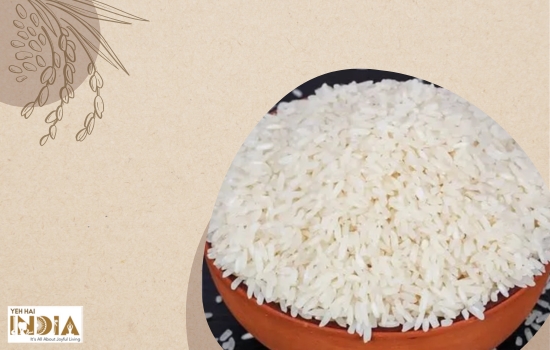
Indrayani rice is a variety of long-grain rice that is predominantly cultivated and consumed in the state of Maharashtra, India. Its grains are slender and have a distinct aroma.
Indrayani rice is highly valued for its quality and is often considered a premium rice variety in Maharashtra. It is commonly used in various Maharashtrian dishes, including steamed rice, pulao, and biryani.
Its versatility and superior quality make it a preferred choice for both everyday meals and special occasions in Maharashtra.
Majorly consumed in Maharashtra.
10. Jeerakasala Rice
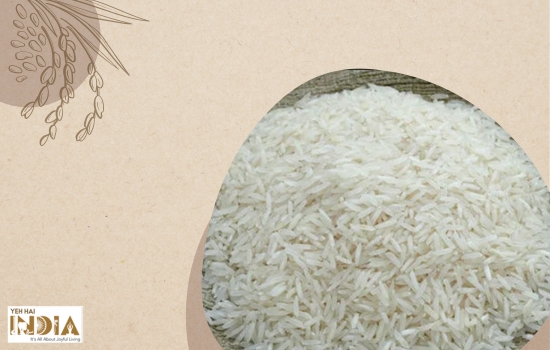
Jeerakasala rice, or Wayanadan Kaima, is a popular flavourful rice variety. It is used in Calicut Biryanis. This is a unique and aromatic variety and is primarily grown in Kerala, India. It is characterized by its small, round grains and cumin-like aroma.
It is commonly used in traditional Kerala dishes such as biryani, pulao, and rice pudding. When cooked, it exhibits a tender and slightly sticky texture, enhancing the overall taste of the dish. Its distinct flavour and aroma contribute to its popularity in Kerala cuisine.
It holds cultural and culinary significance in the region, making it a sought-after choice for those seeking an authentic Kerala culinary experience.
Majorly consumed in Kerala.
11. Kalabati Rice
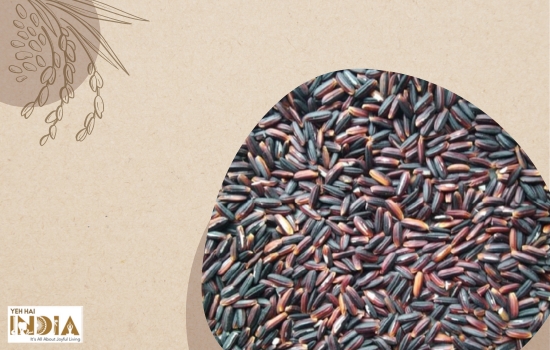
“Kalabati” is a unique indigenous black rice strain known for its impressive height, typically reaching between 5 to 6.5 feet during its growth cycle, which spans around 150 days. It thrives in medium-quality soil and is classified as Mal. Its distinctive leaves display a captivating blend of green and purple hues.
It is primarily cultivated in regions of Asia, including India, China, and Southeast Asian countries. The distinct dark purple or black colour of the rice comes from its rich anthocyanin content, which is an antioxidant.
Black rice has a slightly sweet and nutty flavour, and it has a chewy texture when cooked. Black rice is versatile and can be used in both savoury and sweet dishes, such as salads, stir-fries, and desserts. It has gained popularity in recent years due to its health benefits and culinary appeal.
Majorly consumed in Manipur.
12. Bamboo Rice
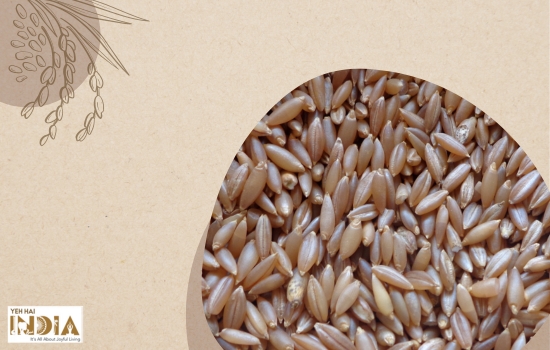
Bamboo rice, also known as Mulayari rice, is a unique and rare type of rice produced from the seeds of flowering bamboo. The grains of bamboo rice have a distinct pale green or yellow colour and a nutty flavour. It has high nutritional value, containing fibre, protein, and essential minerals.
Bamboo rice is harvested only once in several years when bamboo flowers and produces seeds. It is often used in traditional dishes like pulao and payasam (rice pudding) and is prized for its rarity and unique taste.
Due to its limited availability and seasonal nature, bamboo rice is a speciality and a delicacy in certain regions of India.
Majorly consumed in Kerala, Assam and Meghalaya.
13. Matta Rice
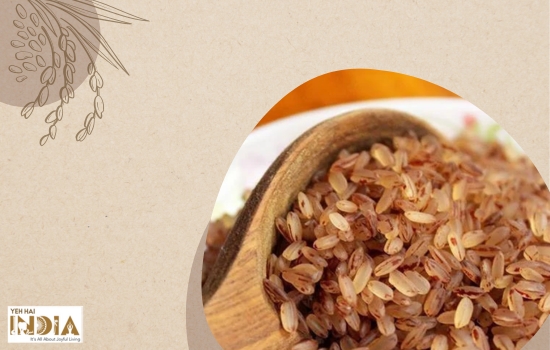
Matta rice is primarily grown in Kerala and Karnataka. This rice variety holds a significant presence in South Indian cuisine. It is used in the preparation of popular dishes like idli and appam.
Matta rice or brown rice has numerous health benefits. Unpolished or whole-grain matta rice retains all its nutrients, while polished rice loses these nutrients. Polishing removes the outer layers, leaving only the carbohydrate content.
Majorly consumed in Goa, Karnataka and Kerala.
14. Miniket Rice

Miniket rice has a delicate flavour and a soft, fluffy texture when cooked. It is commonly used in Bengali cuisine for preparing dishes like pulao, biryani, and sweet rice desserts.
It is also preferred for its ability to absorb flavours, making it suitable for a wide range of savoury and sweet preparations.
Majorly consumed in West Bengal.
15. Parmal Rice
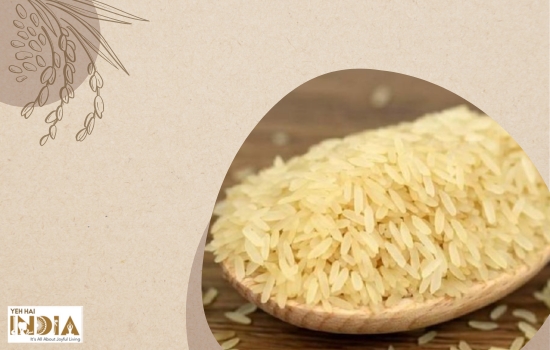
Parmal rice is another one of the popular rice varieties in India. It undergoes a parboiling process that retains nutrients in the bran layer before milling. When cooked, parmal rice yields fluffy and separate grains.
Due to the parboiling process, parmal rice is more nutritious than regular white rice, as it retains vitamins and minerals.
Majorly consumed in Punjab, Haryana and Uttar Pradesh.
16. Rajamudi Rice
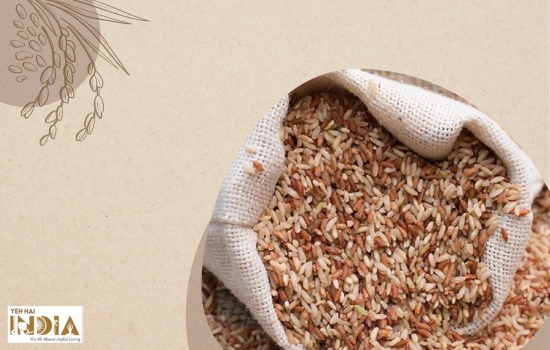
Rajamudi Rice, once favoured by maharajas and now cherished in courtly cuisine and royal kitchens, is a unique rice variety that deserves preservation and appreciation.
Its cultivation is now limited to isolated patches. Rajamudi rice offers a rich flavour and complements various Indian dishes. Compared to polished rice, it boasts a higher dietary fibre content, along with significant amounts of antioxidants and phytonutrients.
These antioxidants protect against infections and free radicals, while zinc contributes to immunity, healing, and heart health.
Majorly consumed in Kerala.
17. Sharbati Rice

Sharbati rice is a popular basmati rice variety known for its delicate aroma, slender grains, and soft texture when cooked. It is primarily grown in the northern states of India, particularly in the fertile regions of Punjab and Haryana.
Sharbati rice has gained recognition for its excellent cooking properties, including its ability to expand in length and retain its shape after cooking. It is often used to prepare fragrant biryanis, pilafs, and other rice-based dishes.
Majorly consumed in Punjab and Haryana.
18. Sugandha Rice
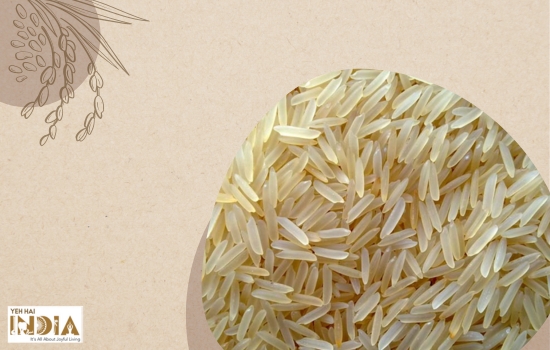
Sugandha rice is a popular variety of basmati rice known for its aromatic fragrance and long, slender grains. It is highly regarded for its excellent cooking characteristics, including its ability to remain separate and fluffy after cooking.
It is commonly used in a variety of rice-based dishes, such as biryanis, pilafs, and pulao. The distinct aroma and delicate flavour of Sugandha rice make it a preferred choice for those seeking an authentic basmati rice experience.
Majorly consumed in Uttar Pradesh, Haryana and Punjab.
Conclusion
Rice is the epitome of versatility, transforming itself in countless ways across different cuisines. It can transition from a humble, unassuming grain into the most delectable and flavorful creations imaginable. The diverse landscape and rich agricultural heritage have given rise to a plethora of rice varieties in India, each with its unique characteristics and culinary significance. Exploring the vibrant tapestry of rice varieties in India reveals not only a rich cultural heritage but also a source of culinary delight that continues to captivate palates worldwide.
Recommended Article: Brown Rice vs. White Rice – The Nutritional Showdown










